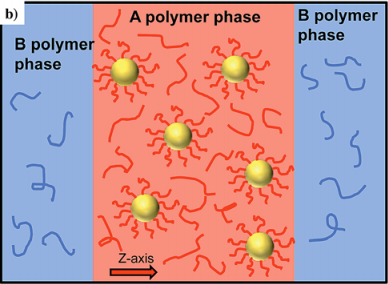Abstract
Polymer nanocomposites are an important and growing class of materials where nanoparticles are mixed in a polymer matrix. Much of the interest in polymer nanocomposites is derived from the nanoparticles’ ability to impart properties to the polymer not commonly found in polymer materials, such as tunable optical, electrical, and mechanical properties. Grafting polymer chains to the surface of a nanoparticle is one of the most common routes towards promoting dispersion of nanoparticles in a polymer matrix. However, we only understand the thermodynamics of grafted nanoparticles in a polymer matrix in the simplest of cases, and this problem is exacerbated by the lack of theoretical and computational tools capable of efficiently predicting the structure of phase separated grafted nanoparticle/polymer blends. In this work, we extend a recently developed field theoretic framework to study the distribution of homogeneously grafted nanoparticles in homopolymer thin films and blends. We demonstrate that our method reproduces trends observed experimentally in homopolymer thin films, and then we examine how the nanoparticle size, grafting density, and the length of the grafted chains relative to the matrix chains affects the distribution of the grafted nanoparticles in phase separated polymer blends. We find that position of the nanoparticles relative to the interface in the blends is sensitive to the brush conformation, even when the nanoparticles are miscible in one of the two homopolymer phases.
